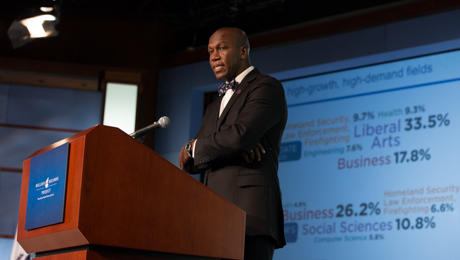A Student Veterans of America study released Monday at the George Washington University revealed 51.7 percent of veterans who have used GI Bill benefits between 2002 and 2010 have earned a postsecondary degree or certificate.
The study, the first of the Million Records Project, analyzed 788,915 veteran education beneficiary records in collaboration with the U.S. Department of Veterans Affairs. That data was cross-referenced with United States postsecondary enrollment and completion records at the National Student Clearinghouse (NCS). The sample represents approximately 22 percent of the student veteran population receiving GI Bill benefits for that period, according to SVA.
“The Million Records Project is the first in-depth look at the academic achievements of today’s generation of student veterans,” SVA Chairman Rodrigo Garcia said at an event in the Jack Morton Auditorium. “Over the next several years, the Million Records Project will build on this baseline data to determine the policies and programs that work for student veterans.”
The findings — “the first of many,” Mr. Garcia said — provide measures of how student veterans perform in the classroom, how long it takes them to complete degrees and what subjects they study.
Grants in excess of $2.2 million from Google, the Kresge Foundation, Lumina Foundation and Raytheon helped fund the project.
Of student veterans who enroll at postsecondary education institutions, 79.2 percent do so at public schools. Among associate degree students, 44.4 percent of graduates studied public sectorjobs—homeland security, law enforcement or firefighting—business or health.
The 51.7 percent completion rate is below the national six-year average of 56.1 percent (as reported in 2013 by the NCS). The completion rate also is not a direct comparison because it does not restrict the timeframe—a result, SVA President and CEO D. Wayne Robinson said, of the various paths veterans take to earn degrees.
“Student veterans are the quintessential non-traditional students,” Mr. Robinson said. “Some joined the military immediately after high school and delayed college enrollment. Others joined the National Guard or reserves and simultaneously enrolled in school. A third group enrolls in school, but ultimately chooses to put education on hold to serve in the military.”
 |
| GW Veterans President Emanuel "Manny" Johnson addresses the crowd at the SVA study announcement. |
These variations, Mr. Robinson explained, extend the timeframe.
“Unlike many non-traditional students, many veterans have to withdraw from school to fulfill military obligations as national guardsmen, reservists, or by being deployed,” he said.
Still, the report suggests veterans who complete postsecondary education options through the GI Bill often continue their education: 31.3 percent of the sample who earned a vocational certificate, 35.8 percent who earned an associate degree and 20.8 percent who earned a bachelor’s degree went on to earn another degree at a higher level.
Abby Kinch, a former Chinese linguist in the Air Force, is one of those students. Ms. Kinch, Mr. Robinson said, attended the Community College of the Air Force and Tallahassee Community College. She currently is a doctoral student at Florida State University.
“Abby is the perfect example of a student veteran who successfully keeps many balls in the air while attending school,” Mr. Robinson said.
SVA plans to replicate this study in the future solely for Post-9/11 GI Bill recipients, in an effort to better understand student veterans’ performance and amend policies to better serve members of the military.
“The post-World War II G.I. Bill educated roughly 10 million returning veterans,” GW Veterans President Emanuel “Manny” Johnson said. “Among them were 14 Nobel Prize winners, 24 Pulitzer Prize winners, three presidents, a dozen senators and three Supreme Court justices. With the work SVA is doing, we will work to double those numbers and create a new greatest generation.”


